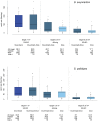Standardizing visual control devices for tsetse flies: East African species Glossina swynnertoni
- PMID: 23469299
- PMCID: PMC3584985
- DOI: 10.1371/journal.pntd.0002063
Standardizing visual control devices for tsetse flies: East African species Glossina swynnertoni
Abstract
Background: Here we set out to standardize long-lasting, visually-attractive devices for Glossina swynnertoni, a vector of both human and animal trypanosomiasis in open savannah in Tanzania and Kenya, and in neighbouring conservation areas used by pastoralists. The goal was to determine the most practical device/material that would induce the strongest landing response in G. swynnertoni for use in area-wide population suppression of this fly with insecticide-impregnated devices.
Methods and findings: Trials were conducted in wet and dry seasons in the Serengeti and Maasai Mara to measure the performance of traps and targets of different sizes and colours, with and without chemical baits, at different population densities and under different environmental conditions. Adhesive film was used as a simple enumerator at these remote locations to compare trapping efficiencies of devices. Independent of season or presence of chemical baits, targets in phthalogen blue or turquoise blue cloth with adhesive film were the best devices for capturing G. swynnertoni in all situations, catching up to 19 times more flies than pyramidal traps. Baiting with chemicals did not affect the relative performance of devices. Fly landings were two times higher on 1 m(2) blue-black targets as on pyramidal traps when equivalent areas of both were covered with adhesive film. Landings on 1 m(2) blue-black targets were compared to those on smaller phthalogen blue 0.5 m(2) all-blue or blue-black-blue cloth targets, and to landings on all-blue plastic 0.32-0.47 m(2) leg panels painted in phthalogen blue. These smaller targets and leg panels captured equivalent numbers of G. swynnertoni per unit area as bigger targets.
Conclusions: Leg panels and 0.5 m(2) cloth targets show promise as cost effective devices for management of G. swynnertoni as they can be used for both control (insecticide-impregnated cloth) and for sampling (rigid plastic with insect glue or adhesive film) of populations.
Conflict of interest statement
The authors have declared that no competing interests exist.
Figures




References
-
- Swynnerton CFM (1936) The tsetse flies of East Africa. Transactions of the Royal Entomological Society 84: 1–579.
-
- Kaare MTK, Picozzi E, Fèvre S, Cleaveland M, Mtambo L, et al. (2007) Sleeping sickness - a re-emerging disease in the Serengeti? Travel Med Infect Dis 5: 117–124. - PubMed
-
- Malele II, Kinung'hi SM, Nyingilili HS, Matemba LE, Sahani JK, et al. (2007) Glossina dynamics in and around the sleeping sickness endemic Serengeti ecosystem of northwestern Tanzania. J Vector Ecol 32: 263–268. - PubMed
-
- Adams ER, Hamilton PB, Malele II, Gibson WC (2008) The identification, diversity and prevalence of trypanosomes in field caught tsetse in Tanzania using ITS-1 primers and fluorescent fragment length barcoding. Infect Genet Evol 8: 439–444. - PubMed
Publication types
MeSH terms
LinkOut - more resources
Full Text Sources
Other Literature Sources

